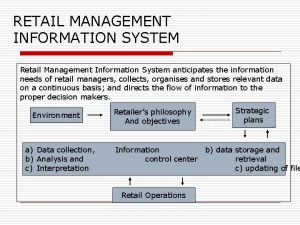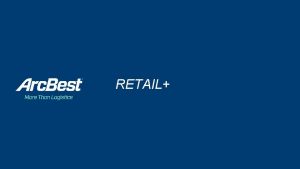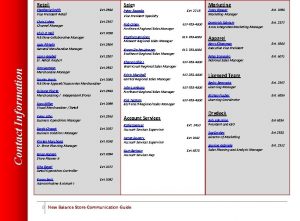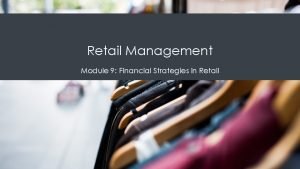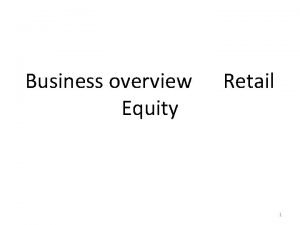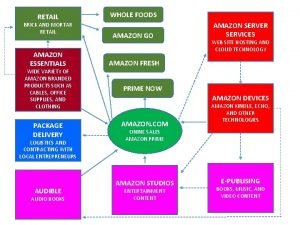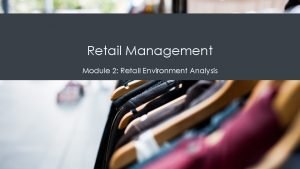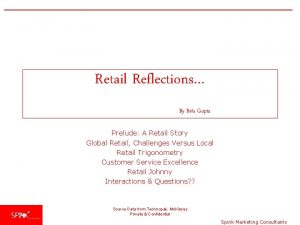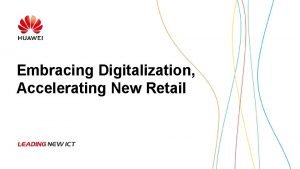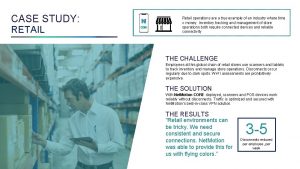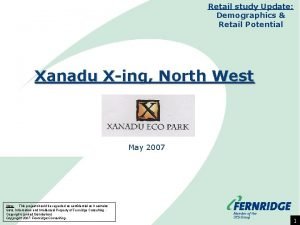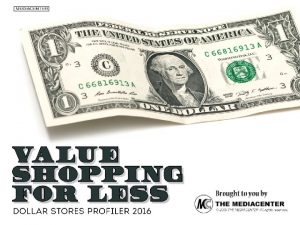THE RETAIL INFORMATION SYSTEM A Retail Information System
























- Slides: 24

THE RETAIL INFORMATION SYSTEM

A Retail Information System anticipates the information needs of retail managers; collects, organizes and stores relevant data on a continuous basis; directs the flow of information to the proper decision makers.

Applications of IT in Retailing n n Automating Processes: Electronic Point of Sales (EPOS), Inventory Planning, Ordering and Management Collecting Data About Customers: Purchasing patterns of customers, segmentation, personalization, customization of offers, loyalty programmes, store design and product placements Feedback on Marketing Decisions: EPOS data to study effects of promotions, prices, new products and packaging changes Communications: With suppliers, customers, internal

Applications of IT in Retailing (contd. ) n n n Tools to Plan the Business: Software to plan, budget, forecast. Adding Value to Retail Transactions: IT-assisted transactions (ATMs) may be preferred by some customers, self-scanning, in-store kiosks for product and info. search. Technologically-enabled Shopping: Internet shopping

Benefits of IT in Retailing Cost and Productivity Benefits • Efficiency of time/transaction speed increases • Reduced queuing times • Operating cost reductions • Increased accuracy of all aspects of the sales transaction • Improved inventory management • Reductions in stock outs and stock holdings

Benefits of IT in Retailing (contd. ) Marketing Benefits Improved data-effectiveness of promotions, forecast of sales • Ability to incorporate faster responses to changing market conditions • Consumer benefits from operational efficiencies – e. g. shorter queues • Can lead to building of loyalty • Additional selling space coz of reduced stockholdings

n n Electronic Point-of-Sale Systems (EPOS) Electronic Funds Transfer at Point of Sale (EFTPOS)

Point-of-Sales (POS) applications The place where a retail transaction occurs is called a point of sale e. g. checkout counter at departmental stores, kiosks, shops etc. A point-of-sale system combines hardware and software to enable a retail transaction to take place. The hardware components in a POS system include credit card devices, bar code scanners, invoice printers etc. The software component is the application that integrates various hardware components during a sale transaction. It includes point-of-sale tasks as well as integrated accounting, CRM and inventory management solutions. The POS application also includes invoicing features to generate bills and invoices. The invoicing feature includes items and prices in a sale and also handles taxes, discounts and various payment options.

CRM is a business strategy that helps companies in increasing their profits by putting customers’ needs at the center of the organization. CRM involves managing and storing customer related information, both sales and service related, to enable companies to provide better services to them. CRM solutions enable companies to create and maintain relationships with customers by tracking their interests, requirements and buying patterns.

The Universal Product Code (UPC) or Barcode n First 3 digits: Country code Next 4 digits: Company code Next 4 digits: Product code Last digit: Check digit

UPC vs SKU n While some may haphazardly interchange the terms UPC and SKU, they are actually two quite different entities. They are both numeric-based codes assigned to products, but UPCs, or Universal Product Codes are standardized for business use and provide a product description that, once scanned, anyone could read. In contrast, a SKU, or Stock Keeping Unit, is a number assigned to a product by the company for stock-keeping purposes and internal operations. n The UPC code is affixed to a product wherever it is sold, remaining a constant throughout the product’s shelf life. Since a SKU is unique to the company, the same product would have different SKUs if sold by different companies, but they would have the same UPC. n Another difference is that SKUs are typically eight alpha-numeric digits, while UPCs are 12 digits, numeric only. n In conclusion, SKUs are for internal use, and UPCs are for external, or universal,

Electronic data Interchange (EDI) With EDI, retailers and suppliers regularly exchange information through their computers with regard to inventory levels, delivery times, unit sales etc of particular items. Both parties enhance their decision-making capabilities, better control inventory and are more responsive to demand.

Quick-Response (QR) Replenishment Systems n n When EPOS are combined with EDI, retailers are in effect adopting just-in-time or quick response (QR) replenishment methods. Reduces stock outs and inventory levels, hence improving service to customers and reducing costs for retailers.

Data-Base Management Procedure a retailer uses to gather, integrate, apply and store information related to a specific subject area. n Involves use of customer data bases, vendor data bases, product category data bases etc. n

Data Bases n n Customer data bases-Purchase frequency, items bought, avg. purchase, demographics, payment methods etc. Vendor data bases- total retailer purchases period, total sales to customer period, most popular items, retailer profit margins, avg. delivery time and service quality

Data Bases (Illustrative) n Product Category Data Bases: Total category sales period, retailer profit margins, percentage of items discounted etc.

Steps in Data-base Management n n n Plan the particular database and its components and determine information needs Acquire the necessary information Retain the information in a usable and accessible format Analyze the data base for organization purposes Update the database regularly

Data Warehousing n n The data warehouse is where information is collected, sorted and stored centrally Components of a data warehouse: 1. Data warehouse, where data are physically stored 2. Software to copy original databases and transfer them to warehouse 3. Interactive software to allow enquiries to be processed 4. Directory for categories of information kept in warehouse.

Data Mining n Data Mining: In-depth analysis of information to gain specific insights about customers, product categories, vendors etc. Relies on special software to sift through vast amounts of info. in a data warehouse to uncover patterns and relationships b/w different factors

Micro Marketing n Application of data mining whereby retailer uses differentiated marketing and develops focused retail strategy mixes for specific customer segments, sometimes fine-tuned for the individual shopper.

Types of Information Systems RIS can be divided into 4 basic types 1. Transaction Processing Systems (TPS) : Used to facilitate customer transactions and other routine business processes (e. g. EPOS systems, payroll and employee record keeping). Critical to operations. Forms major input into other systems

Types of Information Systems (contd. ) Management Information Systems (MIS): To assist middle managers in their monitoring, controlling and decision-making activities. - Provide routine summary or exception reports (usually from transaction data from TPS indicating firm’s current performance) either in the form of a report or online access. -Usually involve pre-specified questions, simple summaries and comparisons. n

Types of Information Systems (contd. ) n Decision Support Systems (DSS): IS designed to assist manager in non-routine semi-structured or unstructured decisions. -Allows user to conduct a ‘what-if’ analyses by changing the assumptions underlying various components of the decision

Types of Information Systems (contd. ) Executive Support Systems : Designed to support senior managers responsible for making strategic decisions- non-routine and require information about trends in the external environment as well as internally. - Incorporates information both from MIS and DSS and external data about economic, competitive and regulatory environment etc. n
 Retail communication mix in retail management
Retail communication mix in retail management Hrm in retail
Hrm in retail What is retail management information system
What is retail management information system Hình ảnh bộ gõ cơ thể búng tay
Hình ảnh bộ gõ cơ thể búng tay Lp html
Lp html Bổ thể
Bổ thể Tỉ lệ cơ thể trẻ em
Tỉ lệ cơ thể trẻ em Chó sói
Chó sói Tư thế worm breton là gì
Tư thế worm breton là gì Hát lên người ơi alleluia
Hát lên người ơi alleluia Môn thể thao bắt đầu bằng từ đua
Môn thể thao bắt đầu bằng từ đua Thế nào là hệ số cao nhất
Thế nào là hệ số cao nhất Các châu lục và đại dương trên thế giới
Các châu lục và đại dương trên thế giới Công của trọng lực
Công của trọng lực Trời xanh đây là của chúng ta thể thơ
Trời xanh đây là của chúng ta thể thơ Mật thư tọa độ 5x5
Mật thư tọa độ 5x5 101012 bằng
101012 bằng độ dài liên kết
độ dài liên kết Các châu lục và đại dương trên thế giới
Các châu lục và đại dương trên thế giới Thơ thất ngôn tứ tuyệt đường luật
Thơ thất ngôn tứ tuyệt đường luật Quá trình desamine hóa có thể tạo ra
Quá trình desamine hóa có thể tạo ra Một số thể thơ truyền thống
Một số thể thơ truyền thống Cái miệng nó xinh thế chỉ nói điều hay thôi
Cái miệng nó xinh thế chỉ nói điều hay thôi Vẽ hình chiếu vuông góc của vật thể sau
Vẽ hình chiếu vuông góc của vật thể sau Nguyên nhân của sự mỏi cơ sinh 8
Nguyên nhân của sự mỏi cơ sinh 8

























